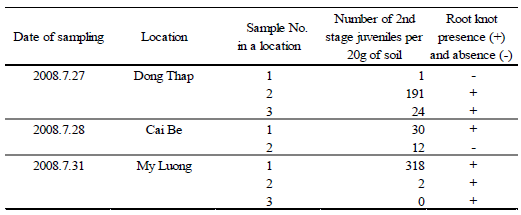First report of the root-knot nematode, Meloidogyne enterolobii, isolated from decaying guava roots in the Mekong Delta, Vietnam
Description
Guava is a very important crop in the Mekong Delta of Vietnam. It yields fruits for several months after transplantation of the seedlings, providing faster income to farmers than other fruit crops. Recently, the joint research studies for citrus greening between JIRCAS and Southern Horticultural Research Institute of Vietnam (SOFRI) revealed that guava interplanted with citrus trees reduced the infection of citrus trees by citrus greening, which is one of the most serious citrus diseases. However, many guava seedlings declined showing yellowing to browning of leaves several months after planting in guava-interplanted citrus groves. In particular, the "Khong hat" variety which was recommended by SOFRI for interplanting has been discovered to be more vulnerable to this problem than other traditionally cultivated varieties. Since diseased seedlings die in a couple of months after the onset of symptoms, it is urgent to establish a control method for this problem.
First symptom of the guava decline was yellowing of the leaves, followed by the expansion of yellowed parts and further browning of leaves (Fig. 1A) until defoliation. The growth of diseased trees was retarded and these trees usually die in a couple of months to one year after expression of the first symptom. Many root knots were observed on the roots of diseased trees even in the early stages of symptom development (Fig. 1B) and root-knot nematodes were taken as specimen from these root knots (Fig. 1C). This problem has widely occurred in southern Vietnam, and nematode juveniles in the second stage were extracted from soil samples collected within the root system of diseased trees (Table 1).
DNA sequence analyses were performed using juveniles which had been hatched from egg masses laid by the nematodes collected from the root knots of diseased trees. The mitochondrial DNA region of COII-16SrDNA of the nematode was amplified by PCR (1). An approximate 700-bp fragment of PCR product was obtained and analyzed, revealing more than 99.6% homology to M. mayaguensis, a synonym of M. enterolobii (2), when aligned with sequence data of isolates from France [(GenBank Accession No. AJ421396), United States (GenBank Accession No. AY446978) and China (GenBank Accession No. AY831967) (Table 2)]. The nematode in guava root knot was formerly identified as M. mayaguensis in other reports, but recently this nematode has been identified as identical to M. enterolobii. Hence, we use the latter’s species name for the nematode problem.
The nematodes which were taken from the root knots of the diseased guavas were inoculated into five intact guavas, the roots of which were infected by the egg masses of nematodes. Juveniles obtained from these egg masses were examined and compared morphologically and genetically with the above nematodes. The results gave the same conclusion: these nematode specimens are M. enterolobii. This is the first confirmation of the incidence of this nematode from Vietnam (3), and the results imply that the pathogen of the guava decline in Southern Vietnam is a nematode of this species.
Interestingly, few or no symptoms of this disease can be detected on the other local variety, "Xa ly nghe", even though planted next to the diseased “Khong hat” guavas. This suggests that the former variety is either resistant or tolerant to the nematode. If this can be confirmed further, “Xa ly nghe” may be used as a resistant root stock for the breeding and cultivation of “Khong hat”.
Figure, table
-
Fig. 1.
Yellowing and discoloration of leaves of guava seedlings (A), root knots observed in the diseased seedlings (B) and a second stage juvenile isolated from the soil around the root knot (C). -
Table 1. Population density of nematodes in fields in Mekong Delta where the severe decline of guava seedlings was observed.
-
Table 2. Identification of mitochondrial DNA COII-16SrDNA region sequences between a Vietnamese isolate from diseased guava and Meloidogyne enterolobii isolates from three other different regions.
- Affiliation
-
Japan International Research Center for Agricultural Sciences Tropical Agriculture Research Front
- Classification
-
Administration B
- Term of research
-
FY2006~2010
- Responsible researcher
-
IWAHORI Hideaki ( Kyushu Okinawa Agricultural Research Center, NARO )
ICHINOSE Katsuya ( Tropical Agriculture Research Front )
TRUC Nguyen Thi Ngoc ( Southern Fruit Research Institute )
BANG Doan V. ( Southern Fruit Research Institute )
- ほか
- Publication, etc.
-
Iwahori H. et al. (2009) Plant Disease 93(6):675.
- Japanese PDF



